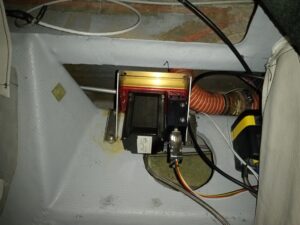11/2019 – 01/2020
The GRT EFIS system has a full 2 axis autopilot system built directly into the Display Units. I had fully intended to utilize the AP system when I ordered the EFIS, but after an incident in a different canard where the controls jammed due to an incorrectly connected pitch trim system, I was very cautious about attaching anything to my flight controls without being 100% certain I could do so safely. Most autopilot servos have clutches and even shear pins that will snap if for some reason they go rogue, and the GRT servos are no different. The thing I learned from incident with the trim system on the other canard was that ensuring the geometry of the servo attachment was properly designed and restricted from going over-center was crucial.
I spent a fair bit of time reviewing the installations others had done, and consulting with some builders I trust. After choosing suitable locations to mount the servos and creating the hard points for the brackets to attach, I then went to work fabricating the attaching linkage and limit stops. For the pitch servo I chose to mount it on the forward face of the instrument panel in the lower passenger corner. The roll servo I grudgingly chose to mount in what is referred to as the ‘hell hole’ in a canard, between the aft landing gear bulkhead and the firewall. It’s an incredibly annoying place to work, but it kept the servo out of the way while still providing clear access to the aileron torque tube.
Mounting and connecting the servos was definitely the part that I spent the most time researching and planning, but the bulk of the installation work was not in physical mounting, but rather in fine tuning the response of the system. Getting the initial settings for servo response and dampening is pretty straight forward with some simple in flight tests in a calibration mode that has you trim the plane for straight and level flight, then disturb the plane in either pitch and roll, adjusting the response settings accordingly.
I found the bulk of my time was spent trying to decide how to tune the system for desired behavior in various flight regimes. The trick for me was deciding on the compromise. There are some behaviors that have adjustment based on mode of operation. How it responds to course deviations for example when tracking a VOR vs deviations in heading when in heading hold mode. Other settings are global in nature, like the bank angle limit, which are enforced in all modes. This meant I had to find a compromise between what I felt passengers might be most comfortable with, and what I would rather have it do when approaching a turn inbound on instrument approach. In this specific case I would then have to adjust the turn anticipation setting to accommodate the lower max bank angle setting I was selecting for passenger comfort.
While it took me a fair bit of time to get it configured the way I wanted, I can’t really call it ‘work’. It was, after all, just time spent in the air doing something I loved. In the end I regretted waiting so long to install the system. It really does a beautiful job of flying the airplane, both in cruise, and when flying instrument approaches. I lovingly named the system ‘Otto’. Since his arrival he’s probably entitled to log more hours at the controls than I am, and he’s arguably better at it. 🙂





